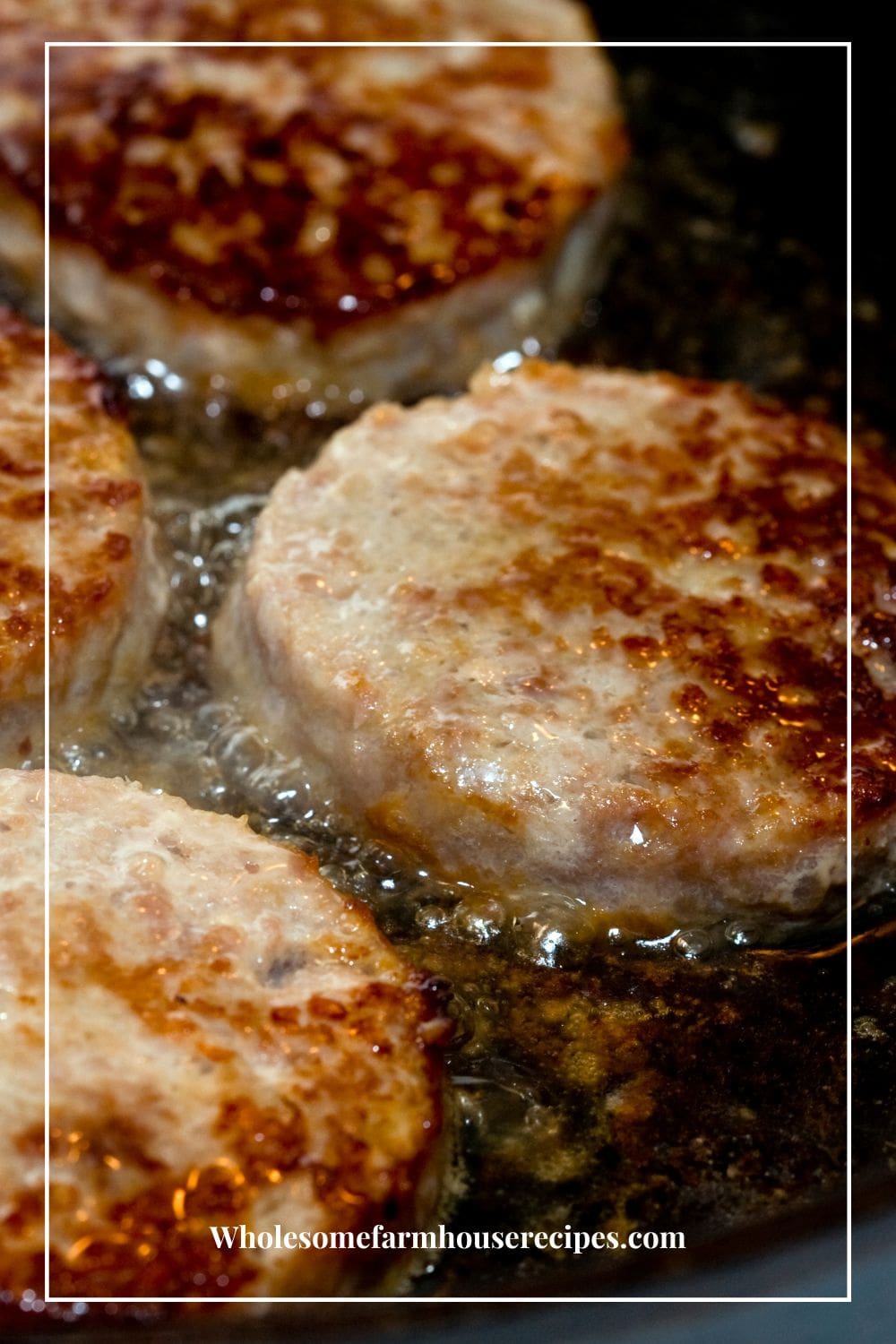Is Country Sausage the Same as Breakfast Sausage? When your recipe calls for sausage and you have Italian or breakfast sausage readily available, does it truly make a difference which one you use? It might be tempting to think that sausage is just sausage, but that’s not the case. In essence, the key distinction between the two lies in the spices they contain.
Country Sausage vs Breakfast Sausage
The terms “country sausage” and “breakfast sausage” are often used interchangeably, but they can have some differences depending on regional variations and personal preferences. Both are types of sausage, but the specific ingredients and flavors can vary.
What is Breakfast Sausage?
Breakfast sausage is a broad category that includes various types of sausages specifically designed to be served at breakfast. They are typically formed into patties or links and can be mild or spicy, depending on the seasoning.
It can be made from a mixture of ground meat products, such as pork or a combination of pork and beef, and is seasoned with spices like sage, thyme, and black pepper. Some varieties are seasoned with maple syrup or brown sugar for a sweeter taste. Whereas other varieties include red pepper flakes or cayenne pepper for a spicy sausage. Additionally, certain breakfast sausages feature flavors enhanced by cured bacon.
People typically fry, grill, or microwave breakfast sausage. Some individuals prefer drizzling maple syrup over their breakfast sausages. Cooked breakfast sausage finds its way into egg casseroles, blending in before baking. The central component of sausage gravy is crumbled sausage combined with white gravy.
What is Country Sausage?
Country style sausage, on the other hand, is a kind of sausage that is more rustic or homemade style of sausage. It may have a coarser grind and include a wider range of spices and herbs. Country sausage can vary significantly from region to region, and different areas may have their own unique recipes and flavors.
In summary, while there can be overlap between the terms, breakfast sausage generally refers to a specific type of sausage intended for breakfast, and country sausage may have a broader and more regional connotation, representing a homemade or rustic style of sausage. It’s always a good idea to check the specific ingredients and seasonings listed on the product or recipe to understand the flavor profile of the sausage in question.
Table of contents

Fresh Country Sausage
People often refer to fresh country sausage as breakfast sausage because it is commonly served with breakfast. This popular type of American sausage is made from pork and mild seasonings. Its origins trace back to rural America, where farmers creatively utilized all parts of a butchered hog.
Fresh country sausage is available in various forms, all of which are raw and need to be cooked. Whether in loose sausage meat, individual links, or longer coils, it offers versatility in preparation.
What Kind of Breakfast Sausages are There?
A Cook’s Thesaurus outlines the sausage-making process, wherein butchers combine ground meat with fat, flavorings, and preservatives. They then stuff this mixture into casings and twist it at intervals to form links. While pork is the most common meat used, butchers may also employ other ground meat such as beef, lamb, veal, turkey, chicken, or game. Occasionally, they use fillers like oatmeal and rice to extend the meat.
The most common forms are found in the grocery store include:
Links. Involve a smoother blend of meats encased and cut widthwise.
Sausage Patties. Less homogenous than sausage links, the meat mixture is pressed into thin discs.
The distinction between breakfast sausage and regular sausage is minimal. Breakfast sausages are predominantly pork meat with fat incorporated in the mix. Whereas, other regular sausages may comprise ground chicken, beef, veal, and occasionally seafood. Variations in seasonings, including preservatives and fillers, contribute to the differences.
Casings can vary, ranging from intestines or artificial casings to stomachs or skins, and sometimes sausages are sold without casings in bulk. Following assembly, a butcher has the option to sell the sausage as fresh or to cure, dry, or precook it in different ways.
According to S. Clyde Weaver Smoked Meats and Cheese, there are many ways to prepare sausage fillings. It’s helpful to understand the difference between these classifications:
Fresh sausage
Fresh sausage is in a raw state when sold in stores, available in ropes, links, or as a loose ground mixture. Before consumption, it is essential to cook this type of sausage.
These sausages are crafted from ground, chopped, or pureed uncooked meat. They are neither cured nor smoked and require thorough cooking. However, it’s essential to puncture the skin or casing before cooking to prevent the sausages from exploding. Cooking options include Oven-baking, grilling, pan-frying, or broiling, and you can also crumble them and incorporate them into sauces.
Cooked sausage
This sausage is made from cooked meat, making it ready to eat upon purchase. Hot dogs are a common example of this type. To maintain their freshness until consumption, it is necessary to refrigerate these meats.
There are other pre-cooked sausages that still need additional cooking before being enjoyed. Examples of such sausages include bratwursts, frankfurters, and bologna.
Smoked sausage
Smoked sausage is either slow smoked or cooked and then smoked. This sausage is ready to eat, but most varieties require refrigeration.
A common deli option are smoked sausages, which are consumed either as they are or lightly cooked. They can also be incorporated into sauces and various dishes to enrich them with a smoky flavor. Examples of this type of sausage include andouille (a pork-based sausage) and kielbasa (a U-shaped Polish sausage).
Semi-dry sausage
As the name suggests, semi-dry varieties are partially dried. This happens while the sausages are smoked. This process thoroughly cooks them. Semi-dry sausages are often shelf stable.
Dried sausage
Fully dry sausage is aged and cured, making it ready to eat without any need for refrigeration. People typically enjoy them as a snack or as part of a meal. You can eat them either as a small stick or as slices from a whole sausage.
It undergoes curing through an air-drying process with controlled time, temperature, and humidity conditions. Referred to as the seminary sausage due to its predominant production in monasteries, this dry sausage is also known as a summer sausage, as it can be stored in warm weather without requiring refrigeration.

What is Italian Sausage?
Italian sausage is a type of pork sausage that is seasoned with a distinctive blend of herbs and spices, giving it a characteristic and robust flavor. It is a popular ingredient in Italian-American cuisine and is used in a variety of dishes. There are different varieties of Italian sausage, but they generally fall into two main categories: sweet (mild) Italian sausage and hot Italian sausage.
Sweet (Mild) Italian Sausage
This type of Italian sausage is seasoned with a blend of herbs such as fennel seed, garlic powder, and sometimes parsley.
It is called “sweet” not because it contains sugar, but to distinguish it from the spicier variety.
Sweet Italian sausage has great flavor, and it is versatile as it works well in a range of dishes, from pasta sauce to soup, and sandwiches.
Hot Italian Sausage
Hot Italian sausage has the same base seasoning as sweet Italian sausage, but it includes additional red pepper flakes or cayenne pepper to add spiciness.
The heat level can vary from a medium heat to very hot, depending on the brand or recipe.
Hot Italian sausage is often used when a bit of heat is desired in dishes like pasta sauces, soups, or pizzas.
Italian sausage is typically made from plain ground pork, but variations may include a mix of pork and ground beef. It is commonly sold in casings as links, and it can be grilled, sautéed, baked, or used in various recipes.
Italian sausage is a key ingredient in many Italian and Italian-American dishes, including pasta dishes like spaghetti with sausage, pizza toppings, Italian sausage and peppers, and more. It adds depth of flavor and a savory, aromatic quality to a variety of recipes.

How to Cook Breakfast Sausage?
Cooking breakfast sausage is a straightforward process, and there are several methods you can use based on your preferences. Here are three common ways to cook breakfast sausage:
Pan-Frying
Ingredients:
Breakfast sausage links or patties
Cooking oil or butter (optional)
Instructions:
Heat a skillet or frying pan over medium heat.
If using patties, add a small amount of cooking oil or butter to the pan to prevent sticking.
Place the sausage links or patties in the pan, ensuring they are not too crowded.
Cook the sausage, turning occasionally, until browned on all sides and cooked through. The internal temperature should reach 160°F (71°C).
Remove the cooked sausage from the pan and place them on a plate lined with paper towels to absorb excess grease.
Baking in the Oven
Ingredients:
Breakfast sausage links or patties
Instructions:
Preheat your oven to the temperature recommended on the sausage packaging (usually around 350°F or 180°C).
Place the sausage links or patties on a baking sheet, leaving some space between each piece.
Bake in the preheated oven for about 15-20 minutes, turning halfway through, until the sausages are browned and cooked through.
Use a meat thermometer to ensure the internal temperature reaches 160°F (71°C).
Microwaving
Ingredients:
Breakfast sausage links or patties
Instructions:
Arrange the sausage links or patties on a microwave-safe plate, leaving space between each piece.
Microwave on high according to the package instructions, usually for 2-4 minutes. Cooking times may vary based on wattage.
Turn the sausages halfway through the cooking time to ensure even cooking.
Check the internal temperature with a meat thermometer, and make sure it reaches 160°F (71°C) before serving.
Regardless of the method you choose, it’s important to ensure that the sausage is cooked thoroughly to a safe internal temperature. Cooking times may vary based on the size and thickness of the sausages, so using a meat thermometer is the most reliable way to check for doneness.

What are some uses for breakfast sausages?
Breakfast sausages are versatile and can be used in a variety of dishes to add flavor and substance. Here are some common uses for breakfast sausages:
Classic Breakfast Plate:
In the United States, they are served alongside eggs, toast, and maybe some hash browns for a traditional breakfast.
Breakfast Burritos or Tacos:
Cook and crumble breakfast sausages to fill burritos or tacos along with scrambled eggs, cheese, and other toppings.
Sausage and Egg Muffins:
Incorporate cooked sausage patties into breakfast sandwiches or muffins. In fact, many fast food restaurants has made this combination into one of the favorite recipes for people in a hurry to grab a nutritious breakfast and get to work.
Sausage Gravy:
Make a classic Southern dish by adding crumbled breakfast sausages to white gravy, then serve over biscuits.
Omelets and Frittatas:
Add cooked and crumbled sausage to omelets or frittatas for a hearty and flavorful breakfast.
Breakfast Casseroles:
Mix cooked breakfast sausages into casseroles with eggs, cheese, bread, and vegetables for a satisfying morning meal.
Sausage and Grits:
Combine sausages with creamy grits for a Southern-inspired breakfast dish.
Stuffed Mushrooms:
Remove the casing, cook, and mix with cheese and herbs to create a delicious stuffing for mushrooms.
Sausage and Cheese Biscuits:
Incorporate cooked and crumbled sausage into biscuit dough along with cheese for savory breakfast biscuits.
Sausage and Potato Hash:
Cook sausages with diced potatoes, onions, and bell peppers for a flavorful breakfast hash.
Sausage-Stuffed Peppers:
Use cooked sausage as a filling for bell peppers, either in halves or as part of a stuffed pepper casserole.
Sausage Skewers:
Thread cooked sausage pieces onto skewers along with vegetables for a breakfast kabob.
Pasta Dishes:
Crumble and cook breakfast sausages to add flavor to pasta dishes like spaghetti or carbonara.
Sausage and Rice:
Mix cooked sausage with rice and vegetables for a quick and tasty breakfast bowl.
Soup or Stew:
Add cooked sausage to breakfast-inspired soups or stews for a comforting meal.
The possibilities are endless, and you can get creative with how you incorporate breakfast sausages into your meals.
What are Italian Sausages used for?
Italian sausage is a versatile ingredient used in a wide range of recipes, adding depth of flavor and a distinctive savory profile. Here are some common uses for Italian sausage in recipes:
Pasta Dishes:
Italian sausage is a popular addition to pasta dishes, such as spaghetti with sausage, penne alla vodka, or sausage and fettuccine Alfredo.
Pizza Toppings:
Crumbled or sliced Italian sausage is a classic pizza topping, providing a flavorful and hearty element to the pizza.
Sausage and Peppers:
Combine with bell peppers and onions to create a classic dish known as “sausage and peppers.” Serve this mixture on its own, in sandwiches, or over rice or pasta.
Stuffed Peppers or Mushrooms:
Remove the casing and use the seasoned sausage meat as a filling for stuffed bell peppers or mushrooms.
Sausage and Egg Breakfast Dishes:
Italian sausage can be included in breakfast recipes, such as omelets, frittatas, or breakfast casseroles, to add a savory kick to morning meals.
Soup and Stew:
Sliced or crumbled Italian sausage is a flavorful addition to soups and stews, providing a rich broth with herbs and spices.
Sandwiches and Subs:
Grilled or sautéed Italian sausage can be served in sandwiches or subs, either on its own or with additional toppings like sautéed onions and peppers.
Italian Sausage and Beans:
Italian sausage pairs well with beans in dishes like cassoulet or Tuscan-style white bean and sausage stew.
Sausage and Rice Dishes:
Mix with rice and vegetables to create hearty and flavorful one-pot meals.
Appetizers:
Use in appetizers, such as sausage-stuffed mushrooms, sausage-stuffed jalapeños, or sausage and cheese platters.
Calzones and Stromboli:
Folded into pizza dough, Italian sausage becomes a delicious filling for calzones or stromboli.
Sausage Gravy:
Crumbled Italian sausage is a key ingredient in making sausage gravy, which is often served over biscuits in Southern cuisine.
Whether it’s crumbled, sliced, or used as whole links, Italian sausage contributes a rich, savory flavor to a variety of dishes, making it a versatile and popular ingredient in many cuisines.
Here are other delicious recipes and cooking tips for you to explore.






